Analysis of Reverse Logistics in Supply Chain Management
VerifiedAdded on 2022/11/26
|12
|3018
|277
Report
AI Summary
This report delves into the critical role of reverse logistics within supply chain management. It begins by defining reverse logistics and outlining its conceptual background, including definitions, characteristics, and real-world examples. The report emphasizes the significance of reverse logistics, highlighting its positive impact on customer satisfaction, environmental sustainability, and brand reputation. It explores the interaction between reverse logistics and the broader supply chain, demonstrating how it facilitates and enhances supply chain operations. Furthermore, the report discusses the implications of reverse logistics for organizations, supply chains, customers, and the community, covering both positive and negative aspects. Finally, it examines the future directions of reverse logistics, anticipating its increasing adoption by businesses due to its multifaceted benefits. The report concludes by underscoring the strategic importance of reverse logistics in modern business practices.
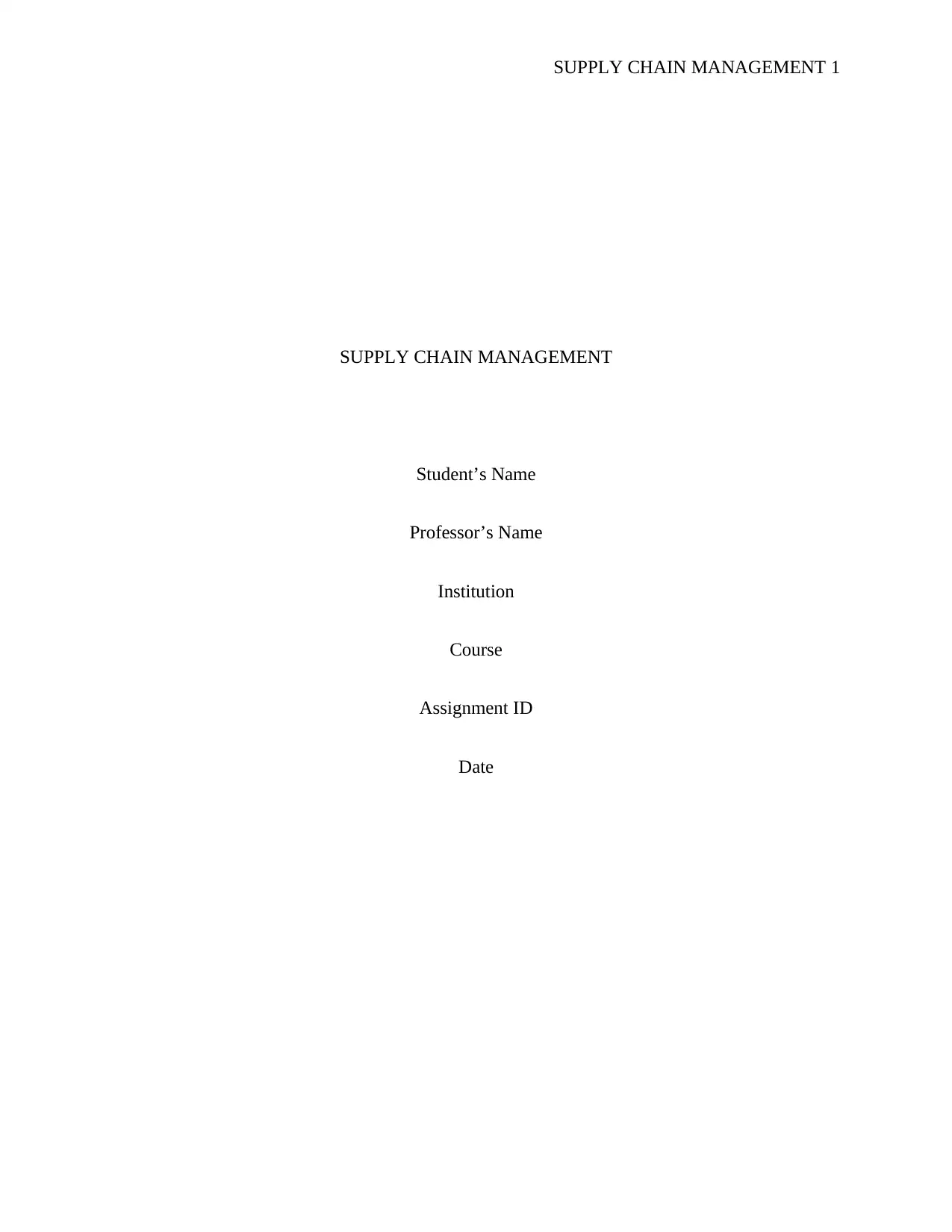
SUPPLY CHAIN MANAGEMENT 1
SUPPLY CHAIN MANAGEMENT
Student’s Name
Professor’s Name
Institution
Course
Assignment ID
Date
SUPPLY CHAIN MANAGEMENT
Student’s Name
Professor’s Name
Institution
Course
Assignment ID
Date
Paraphrase This Document
Need a fresh take? Get an instant paraphrase of this document with our AI Paraphraser
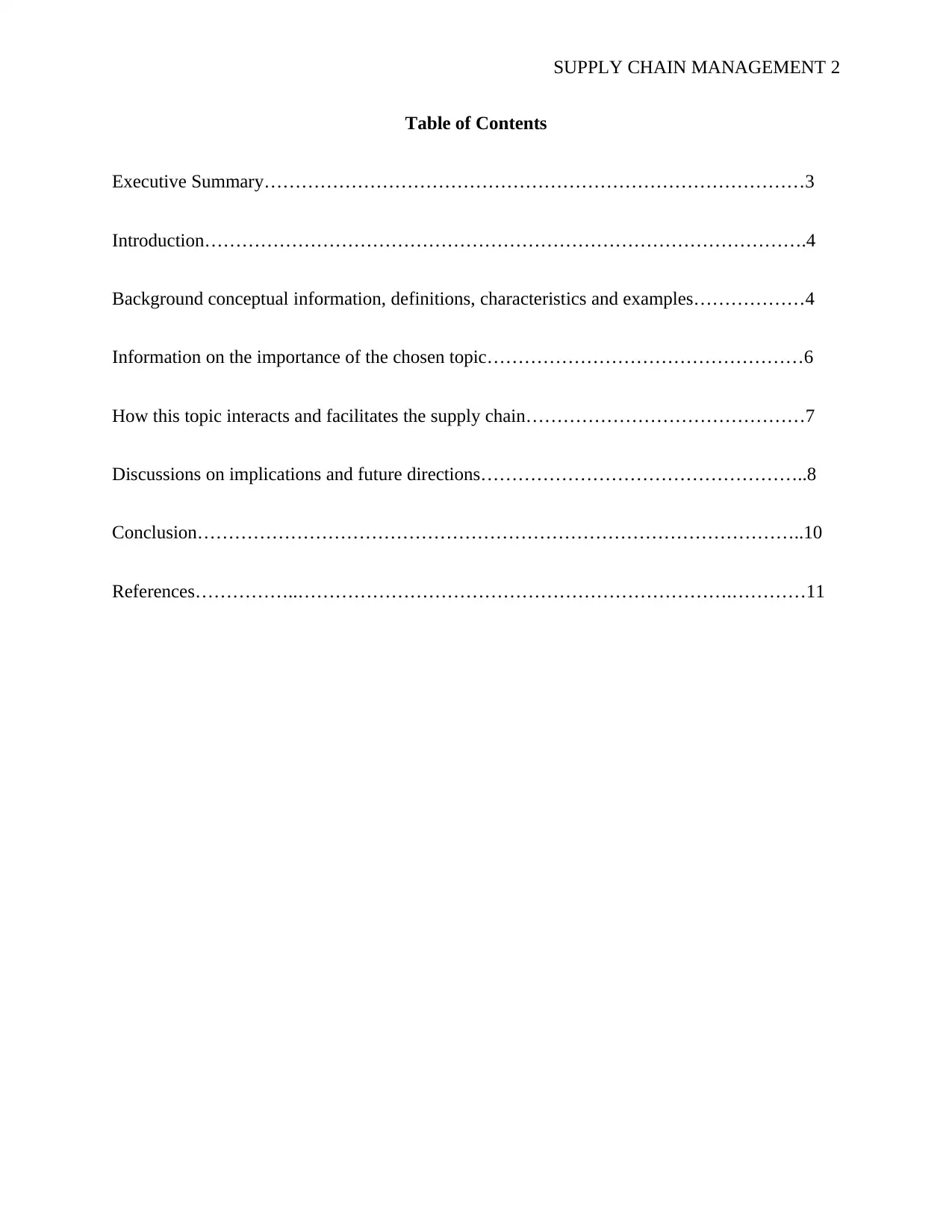
SUPPLY CHAIN MANAGEMENT 2
Table of Contents
Executive Summary……………………………………………………………………………3
Introduction…………………………………………………………………………………….4
Background conceptual information, definitions, characteristics and examples………………4
Information on the importance of the chosen topic……………………………………………6
How this topic interacts and facilitates the supply chain………………………………………7
Discussions on implications and future directions……………………………………………..8
Conclusion……………………………………………………………………………………..10
References……………..…………………………………………………………….…………11
Table of Contents
Executive Summary……………………………………………………………………………3
Introduction…………………………………………………………………………………….4
Background conceptual information, definitions, characteristics and examples………………4
Information on the importance of the chosen topic……………………………………………6
How this topic interacts and facilitates the supply chain………………………………………7
Discussions on implications and future directions……………………………………………..8
Conclusion……………………………………………………………………………………..10
References……………..…………………………………………………………….…………11
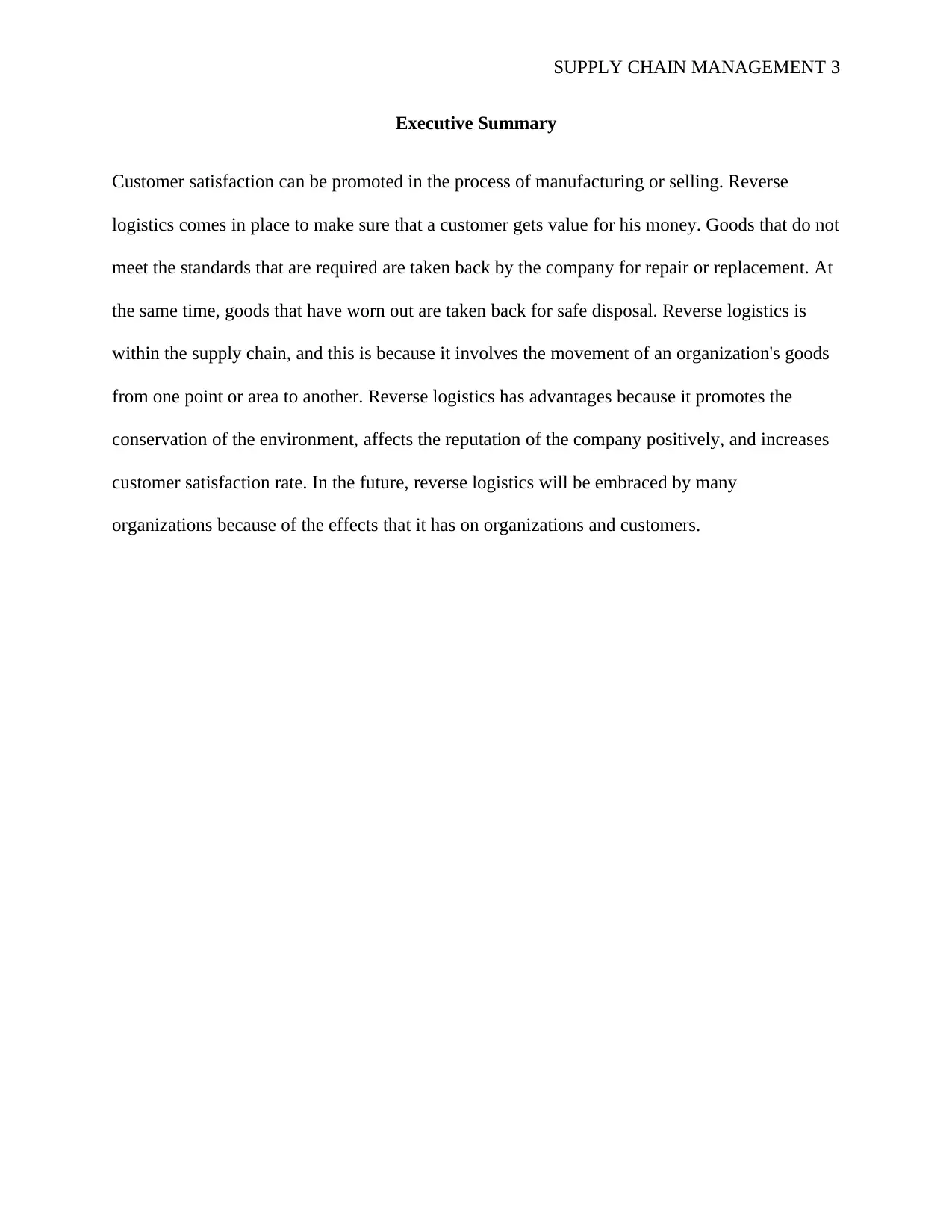
SUPPLY CHAIN MANAGEMENT 3
Executive Summary
Customer satisfaction can be promoted in the process of manufacturing or selling. Reverse
logistics comes in place to make sure that a customer gets value for his money. Goods that do not
meet the standards that are required are taken back by the company for repair or replacement. At
the same time, goods that have worn out are taken back for safe disposal. Reverse logistics is
within the supply chain, and this is because it involves the movement of an organization's goods
from one point or area to another. Reverse logistics has advantages because it promotes the
conservation of the environment, affects the reputation of the company positively, and increases
customer satisfaction rate. In the future, reverse logistics will be embraced by many
organizations because of the effects that it has on organizations and customers.
Executive Summary
Customer satisfaction can be promoted in the process of manufacturing or selling. Reverse
logistics comes in place to make sure that a customer gets value for his money. Goods that do not
meet the standards that are required are taken back by the company for repair or replacement. At
the same time, goods that have worn out are taken back for safe disposal. Reverse logistics is
within the supply chain, and this is because it involves the movement of an organization's goods
from one point or area to another. Reverse logistics has advantages because it promotes the
conservation of the environment, affects the reputation of the company positively, and increases
customer satisfaction rate. In the future, reverse logistics will be embraced by many
organizations because of the effects that it has on organizations and customers.
⊘ This is a preview!⊘
Do you want full access?
Subscribe today to unlock all pages.

Trusted by 1+ million students worldwide
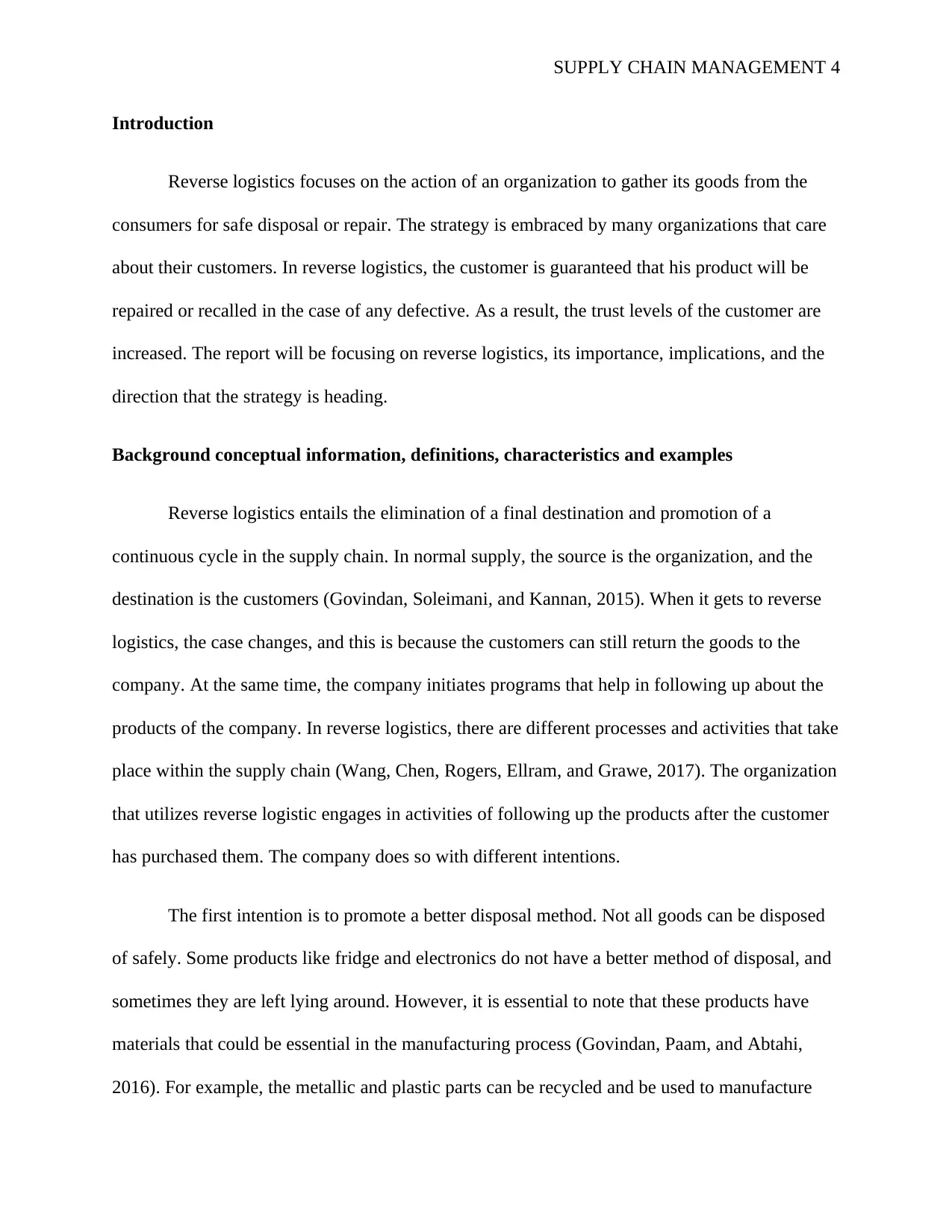
SUPPLY CHAIN MANAGEMENT 4
Introduction
Reverse logistics focuses on the action of an organization to gather its goods from the
consumers for safe disposal or repair. The strategy is embraced by many organizations that care
about their customers. In reverse logistics, the customer is guaranteed that his product will be
repaired or recalled in the case of any defective. As a result, the trust levels of the customer are
increased. The report will be focusing on reverse logistics, its importance, implications, and the
direction that the strategy is heading.
Background conceptual information, definitions, characteristics and examples
Reverse logistics entails the elimination of a final destination and promotion of a
continuous cycle in the supply chain. In normal supply, the source is the organization, and the
destination is the customers (Govindan, Soleimani, and Kannan, 2015). When it gets to reverse
logistics, the case changes, and this is because the customers can still return the goods to the
company. At the same time, the company initiates programs that help in following up about the
products of the company. In reverse logistics, there are different processes and activities that take
place within the supply chain (Wang, Chen, Rogers, Ellram, and Grawe, 2017). The organization
that utilizes reverse logistic engages in activities of following up the products after the customer
has purchased them. The company does so with different intentions.
The first intention is to promote a better disposal method. Not all goods can be disposed
of safely. Some products like fridge and electronics do not have a better method of disposal, and
sometimes they are left lying around. However, it is essential to note that these products have
materials that could be essential in the manufacturing process (Govindan, Paam, and Abtahi,
2016). For example, the metallic and plastic parts can be recycled and be used to manufacture
Introduction
Reverse logistics focuses on the action of an organization to gather its goods from the
consumers for safe disposal or repair. The strategy is embraced by many organizations that care
about their customers. In reverse logistics, the customer is guaranteed that his product will be
repaired or recalled in the case of any defective. As a result, the trust levels of the customer are
increased. The report will be focusing on reverse logistics, its importance, implications, and the
direction that the strategy is heading.
Background conceptual information, definitions, characteristics and examples
Reverse logistics entails the elimination of a final destination and promotion of a
continuous cycle in the supply chain. In normal supply, the source is the organization, and the
destination is the customers (Govindan, Soleimani, and Kannan, 2015). When it gets to reverse
logistics, the case changes, and this is because the customers can still return the goods to the
company. At the same time, the company initiates programs that help in following up about the
products of the company. In reverse logistics, there are different processes and activities that take
place within the supply chain (Wang, Chen, Rogers, Ellram, and Grawe, 2017). The organization
that utilizes reverse logistic engages in activities of following up the products after the customer
has purchased them. The company does so with different intentions.
The first intention is to promote a better disposal method. Not all goods can be disposed
of safely. Some products like fridge and electronics do not have a better method of disposal, and
sometimes they are left lying around. However, it is essential to note that these products have
materials that could be essential in the manufacturing process (Govindan, Paam, and Abtahi,
2016). For example, the metallic and plastic parts can be recycled and be used to manufacture
Paraphrase This Document
Need a fresh take? Get an instant paraphrase of this document with our AI Paraphraser
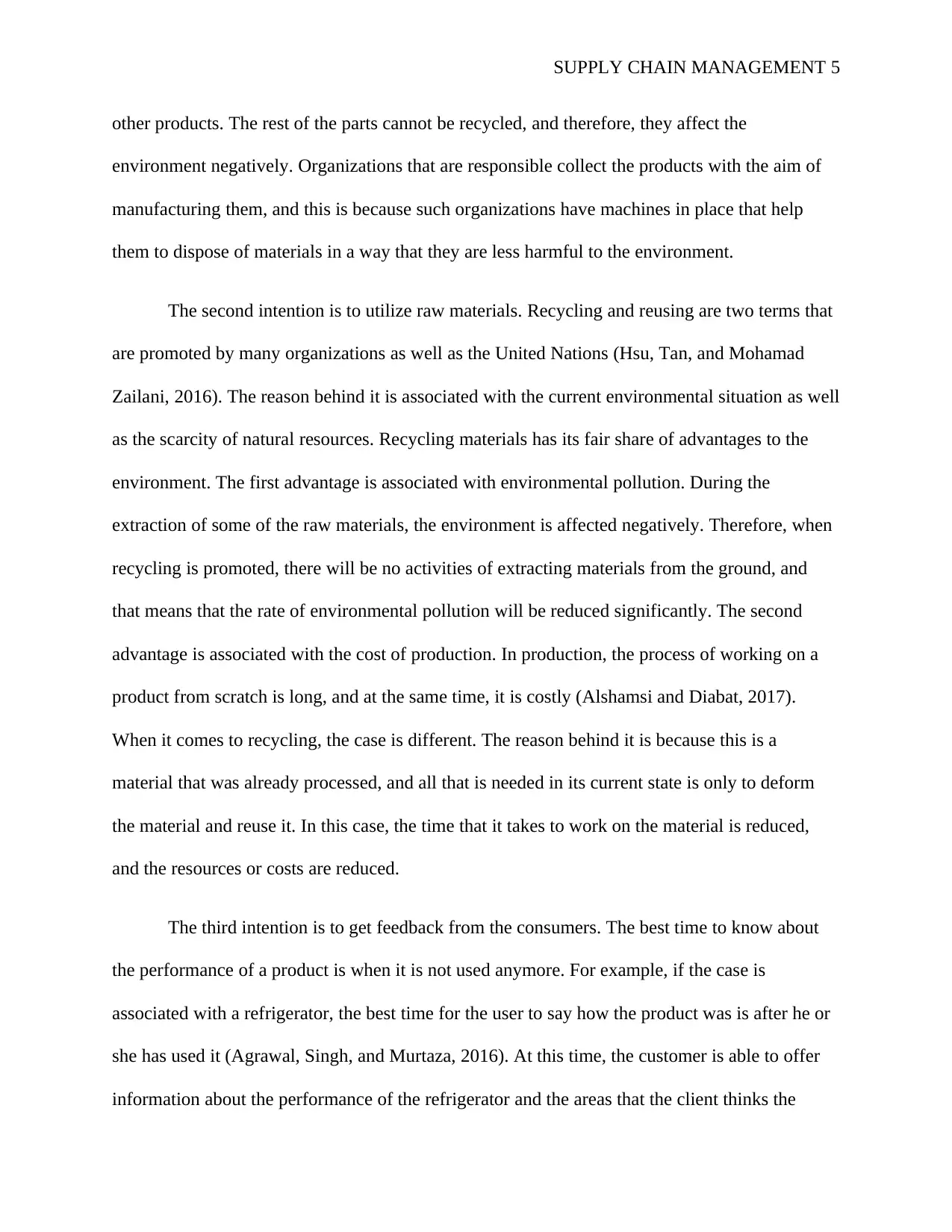
SUPPLY CHAIN MANAGEMENT 5
other products. The rest of the parts cannot be recycled, and therefore, they affect the
environment negatively. Organizations that are responsible collect the products with the aim of
manufacturing them, and this is because such organizations have machines in place that help
them to dispose of materials in a way that they are less harmful to the environment.
The second intention is to utilize raw materials. Recycling and reusing are two terms that
are promoted by many organizations as well as the United Nations (Hsu, Tan, and Mohamad
Zailani, 2016). The reason behind it is associated with the current environmental situation as well
as the scarcity of natural resources. Recycling materials has its fair share of advantages to the
environment. The first advantage is associated with environmental pollution. During the
extraction of some of the raw materials, the environment is affected negatively. Therefore, when
recycling is promoted, there will be no activities of extracting materials from the ground, and
that means that the rate of environmental pollution will be reduced significantly. The second
advantage is associated with the cost of production. In production, the process of working on a
product from scratch is long, and at the same time, it is costly (Alshamsi and Diabat, 2017).
When it comes to recycling, the case is different. The reason behind it is because this is a
material that was already processed, and all that is needed in its current state is only to deform
the material and reuse it. In this case, the time that it takes to work on the material is reduced,
and the resources or costs are reduced.
The third intention is to get feedback from the consumers. The best time to know about
the performance of a product is when it is not used anymore. For example, if the case is
associated with a refrigerator, the best time for the user to say how the product was is after he or
she has used it (Agrawal, Singh, and Murtaza, 2016). At this time, the customer is able to offer
information about the performance of the refrigerator and the areas that the client thinks the
other products. The rest of the parts cannot be recycled, and therefore, they affect the
environment negatively. Organizations that are responsible collect the products with the aim of
manufacturing them, and this is because such organizations have machines in place that help
them to dispose of materials in a way that they are less harmful to the environment.
The second intention is to utilize raw materials. Recycling and reusing are two terms that
are promoted by many organizations as well as the United Nations (Hsu, Tan, and Mohamad
Zailani, 2016). The reason behind it is associated with the current environmental situation as well
as the scarcity of natural resources. Recycling materials has its fair share of advantages to the
environment. The first advantage is associated with environmental pollution. During the
extraction of some of the raw materials, the environment is affected negatively. Therefore, when
recycling is promoted, there will be no activities of extracting materials from the ground, and
that means that the rate of environmental pollution will be reduced significantly. The second
advantage is associated with the cost of production. In production, the process of working on a
product from scratch is long, and at the same time, it is costly (Alshamsi and Diabat, 2017).
When it comes to recycling, the case is different. The reason behind it is because this is a
material that was already processed, and all that is needed in its current state is only to deform
the material and reuse it. In this case, the time that it takes to work on the material is reduced,
and the resources or costs are reduced.
The third intention is to get feedback from the consumers. The best time to know about
the performance of a product is when it is not used anymore. For example, if the case is
associated with a refrigerator, the best time for the user to say how the product was is after he or
she has used it (Agrawal, Singh, and Murtaza, 2016). At this time, the customer is able to offer
information about the performance of the refrigerator and the areas that the client thinks the
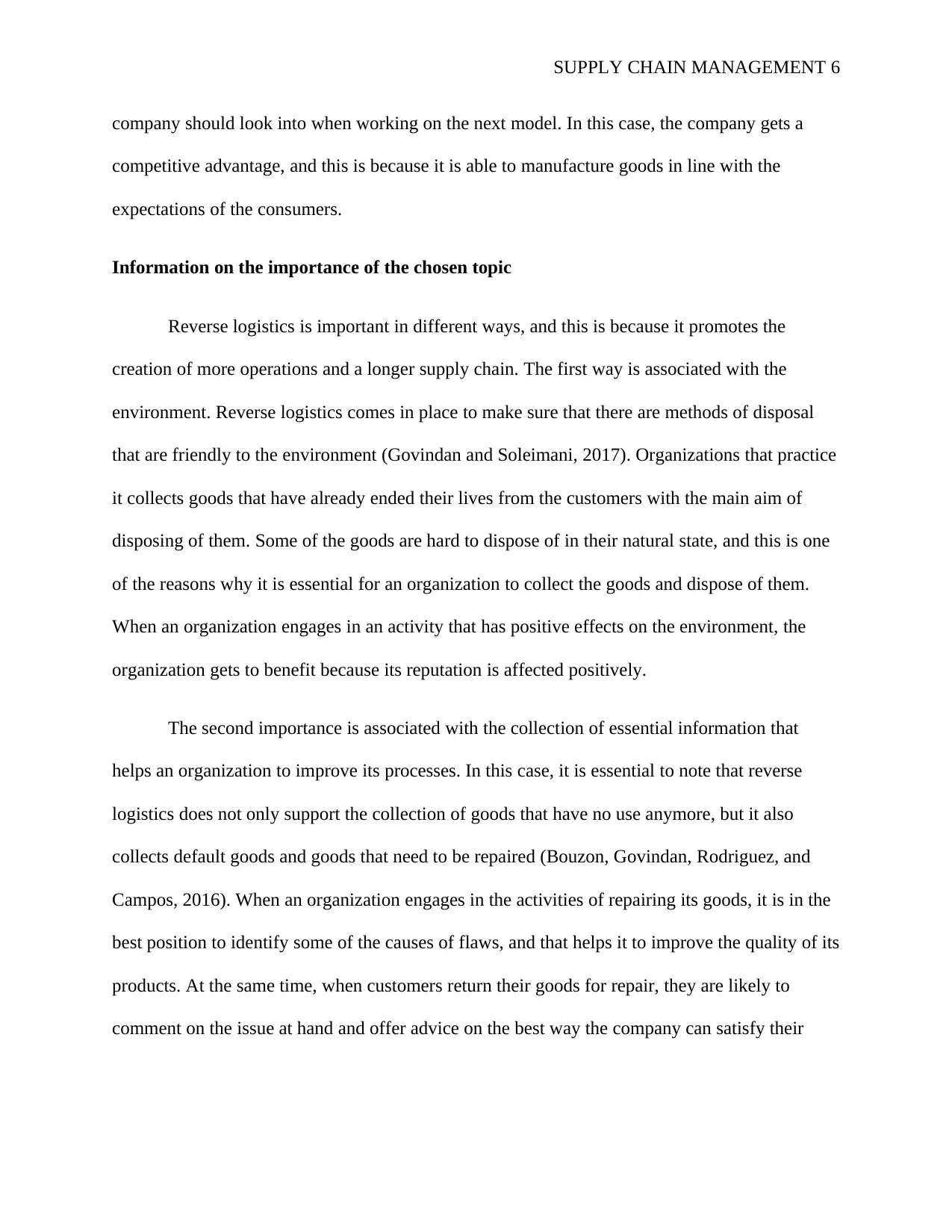
SUPPLY CHAIN MANAGEMENT 6
company should look into when working on the next model. In this case, the company gets a
competitive advantage, and this is because it is able to manufacture goods in line with the
expectations of the consumers.
Information on the importance of the chosen topic
Reverse logistics is important in different ways, and this is because it promotes the
creation of more operations and a longer supply chain. The first way is associated with the
environment. Reverse logistics comes in place to make sure that there are methods of disposal
that are friendly to the environment (Govindan and Soleimani, 2017). Organizations that practice
it collects goods that have already ended their lives from the customers with the main aim of
disposing of them. Some of the goods are hard to dispose of in their natural state, and this is one
of the reasons why it is essential for an organization to collect the goods and dispose of them.
When an organization engages in an activity that has positive effects on the environment, the
organization gets to benefit because its reputation is affected positively.
The second importance is associated with the collection of essential information that
helps an organization to improve its processes. In this case, it is essential to note that reverse
logistics does not only support the collection of goods that have no use anymore, but it also
collects default goods and goods that need to be repaired (Bouzon, Govindan, Rodriguez, and
Campos, 2016). When an organization engages in the activities of repairing its goods, it is in the
best position to identify some of the causes of flaws, and that helps it to improve the quality of its
products. At the same time, when customers return their goods for repair, they are likely to
comment on the issue at hand and offer advice on the best way the company can satisfy their
company should look into when working on the next model. In this case, the company gets a
competitive advantage, and this is because it is able to manufacture goods in line with the
expectations of the consumers.
Information on the importance of the chosen topic
Reverse logistics is important in different ways, and this is because it promotes the
creation of more operations and a longer supply chain. The first way is associated with the
environment. Reverse logistics comes in place to make sure that there are methods of disposal
that are friendly to the environment (Govindan and Soleimani, 2017). Organizations that practice
it collects goods that have already ended their lives from the customers with the main aim of
disposing of them. Some of the goods are hard to dispose of in their natural state, and this is one
of the reasons why it is essential for an organization to collect the goods and dispose of them.
When an organization engages in an activity that has positive effects on the environment, the
organization gets to benefit because its reputation is affected positively.
The second importance is associated with the collection of essential information that
helps an organization to improve its processes. In this case, it is essential to note that reverse
logistics does not only support the collection of goods that have no use anymore, but it also
collects default goods and goods that need to be repaired (Bouzon, Govindan, Rodriguez, and
Campos, 2016). When an organization engages in the activities of repairing its goods, it is in the
best position to identify some of the causes of flaws, and that helps it to improve the quality of its
products. At the same time, when customers return their goods for repair, they are likely to
comment on the issue at hand and offer advice on the best way the company can satisfy their
⊘ This is a preview!⊘
Do you want full access?
Subscribe today to unlock all pages.

Trusted by 1+ million students worldwide
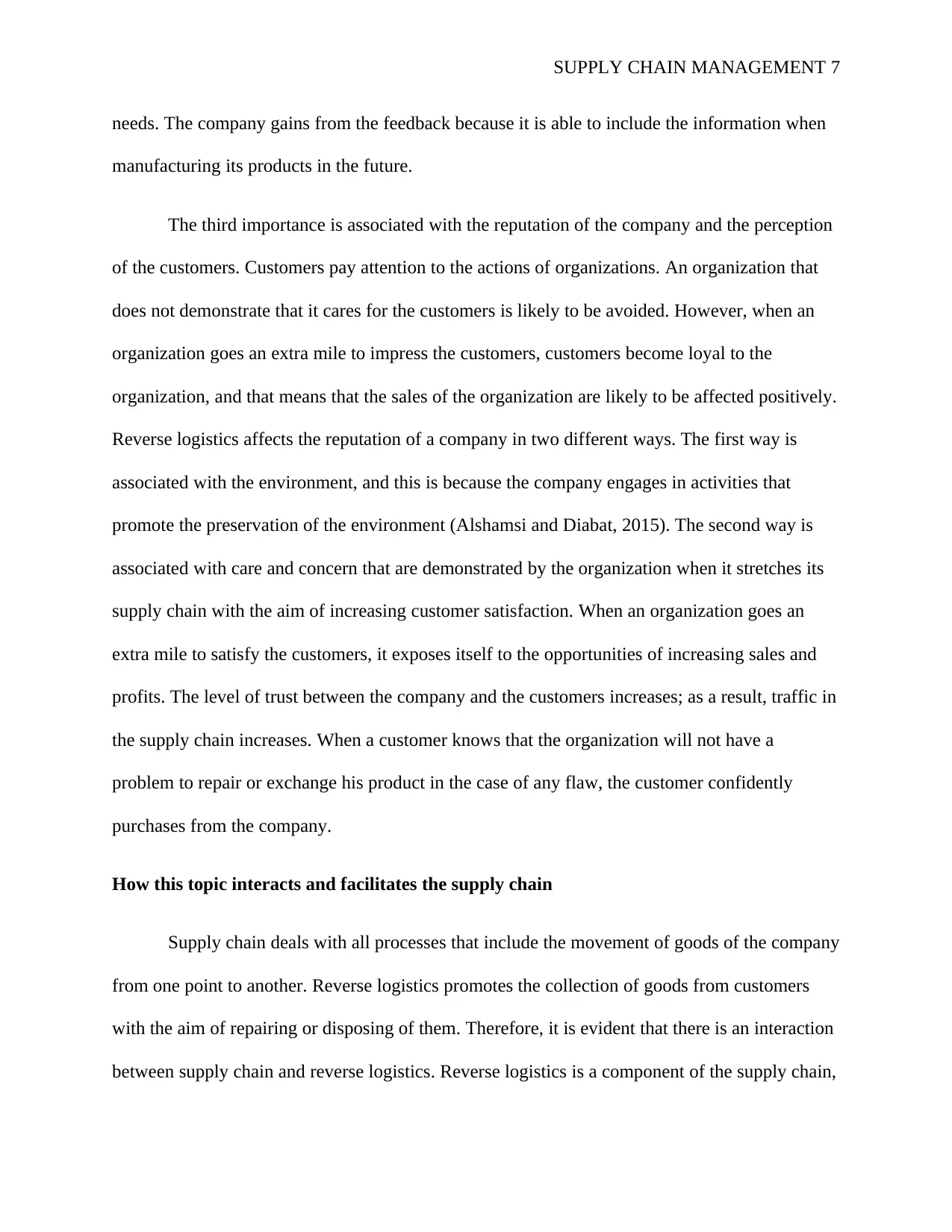
SUPPLY CHAIN MANAGEMENT 7
needs. The company gains from the feedback because it is able to include the information when
manufacturing its products in the future.
The third importance is associated with the reputation of the company and the perception
of the customers. Customers pay attention to the actions of organizations. An organization that
does not demonstrate that it cares for the customers is likely to be avoided. However, when an
organization goes an extra mile to impress the customers, customers become loyal to the
organization, and that means that the sales of the organization are likely to be affected positively.
Reverse logistics affects the reputation of a company in two different ways. The first way is
associated with the environment, and this is because the company engages in activities that
promote the preservation of the environment (Alshamsi and Diabat, 2015). The second way is
associated with care and concern that are demonstrated by the organization when it stretches its
supply chain with the aim of increasing customer satisfaction. When an organization goes an
extra mile to satisfy the customers, it exposes itself to the opportunities of increasing sales and
profits. The level of trust between the company and the customers increases; as a result, traffic in
the supply chain increases. When a customer knows that the organization will not have a
problem to repair or exchange his product in the case of any flaw, the customer confidently
purchases from the company.
How this topic interacts and facilitates the supply chain
Supply chain deals with all processes that include the movement of goods of the company
from one point to another. Reverse logistics promotes the collection of goods from customers
with the aim of repairing or disposing of them. Therefore, it is evident that there is an interaction
between supply chain and reverse logistics. Reverse logistics is a component of the supply chain,
needs. The company gains from the feedback because it is able to include the information when
manufacturing its products in the future.
The third importance is associated with the reputation of the company and the perception
of the customers. Customers pay attention to the actions of organizations. An organization that
does not demonstrate that it cares for the customers is likely to be avoided. However, when an
organization goes an extra mile to impress the customers, customers become loyal to the
organization, and that means that the sales of the organization are likely to be affected positively.
Reverse logistics affects the reputation of a company in two different ways. The first way is
associated with the environment, and this is because the company engages in activities that
promote the preservation of the environment (Alshamsi and Diabat, 2015). The second way is
associated with care and concern that are demonstrated by the organization when it stretches its
supply chain with the aim of increasing customer satisfaction. When an organization goes an
extra mile to satisfy the customers, it exposes itself to the opportunities of increasing sales and
profits. The level of trust between the company and the customers increases; as a result, traffic in
the supply chain increases. When a customer knows that the organization will not have a
problem to repair or exchange his product in the case of any flaw, the customer confidently
purchases from the company.
How this topic interacts and facilitates the supply chain
Supply chain deals with all processes that include the movement of goods of the company
from one point to another. Reverse logistics promotes the collection of goods from customers
with the aim of repairing or disposing of them. Therefore, it is evident that there is an interaction
between supply chain and reverse logistics. Reverse logistics is a component of the supply chain,
Paraphrase This Document
Need a fresh take? Get an instant paraphrase of this document with our AI Paraphraser
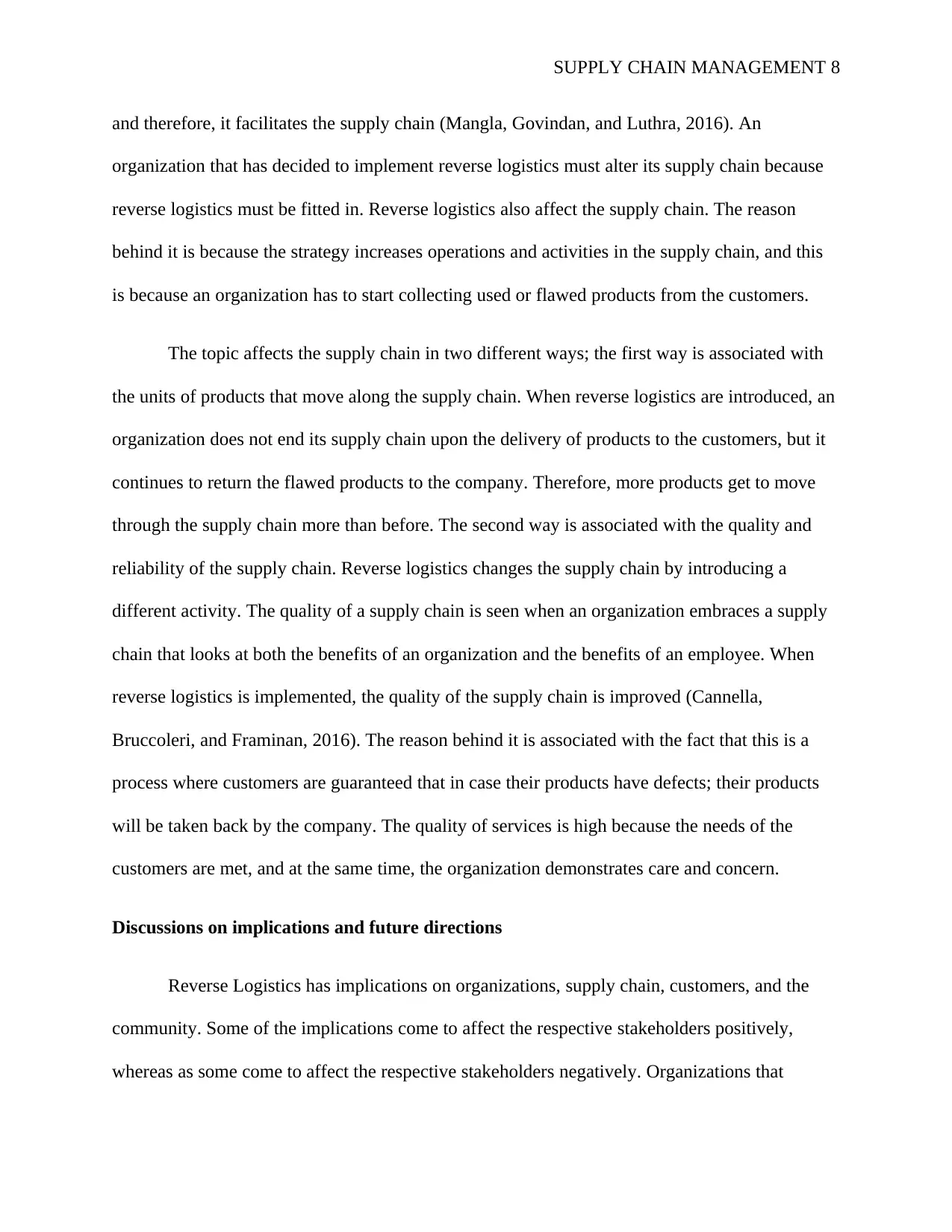
SUPPLY CHAIN MANAGEMENT 8
and therefore, it facilitates the supply chain (Mangla, Govindan, and Luthra, 2016). An
organization that has decided to implement reverse logistics must alter its supply chain because
reverse logistics must be fitted in. Reverse logistics also affect the supply chain. The reason
behind it is because the strategy increases operations and activities in the supply chain, and this
is because an organization has to start collecting used or flawed products from the customers.
The topic affects the supply chain in two different ways; the first way is associated with
the units of products that move along the supply chain. When reverse logistics are introduced, an
organization does not end its supply chain upon the delivery of products to the customers, but it
continues to return the flawed products to the company. Therefore, more products get to move
through the supply chain more than before. The second way is associated with the quality and
reliability of the supply chain. Reverse logistics changes the supply chain by introducing a
different activity. The quality of a supply chain is seen when an organization embraces a supply
chain that looks at both the benefits of an organization and the benefits of an employee. When
reverse logistics is implemented, the quality of the supply chain is improved (Cannella,
Bruccoleri, and Framinan, 2016). The reason behind it is associated with the fact that this is a
process where customers are guaranteed that in case their products have defects; their products
will be taken back by the company. The quality of services is high because the needs of the
customers are met, and at the same time, the organization demonstrates care and concern.
Discussions on implications and future directions
Reverse Logistics has implications on organizations, supply chain, customers, and the
community. Some of the implications come to affect the respective stakeholders positively,
whereas as some come to affect the respective stakeholders negatively. Organizations that
and therefore, it facilitates the supply chain (Mangla, Govindan, and Luthra, 2016). An
organization that has decided to implement reverse logistics must alter its supply chain because
reverse logistics must be fitted in. Reverse logistics also affect the supply chain. The reason
behind it is because the strategy increases operations and activities in the supply chain, and this
is because an organization has to start collecting used or flawed products from the customers.
The topic affects the supply chain in two different ways; the first way is associated with
the units of products that move along the supply chain. When reverse logistics are introduced, an
organization does not end its supply chain upon the delivery of products to the customers, but it
continues to return the flawed products to the company. Therefore, more products get to move
through the supply chain more than before. The second way is associated with the quality and
reliability of the supply chain. Reverse logistics changes the supply chain by introducing a
different activity. The quality of a supply chain is seen when an organization embraces a supply
chain that looks at both the benefits of an organization and the benefits of an employee. When
reverse logistics is implemented, the quality of the supply chain is improved (Cannella,
Bruccoleri, and Framinan, 2016). The reason behind it is associated with the fact that this is a
process where customers are guaranteed that in case their products have defects; their products
will be taken back by the company. The quality of services is high because the needs of the
customers are met, and at the same time, the organization demonstrates care and concern.
Discussions on implications and future directions
Reverse Logistics has implications on organizations, supply chain, customers, and the
community. Some of the implications come to affect the respective stakeholders positively,
whereas as some come to affect the respective stakeholders negatively. Organizations that
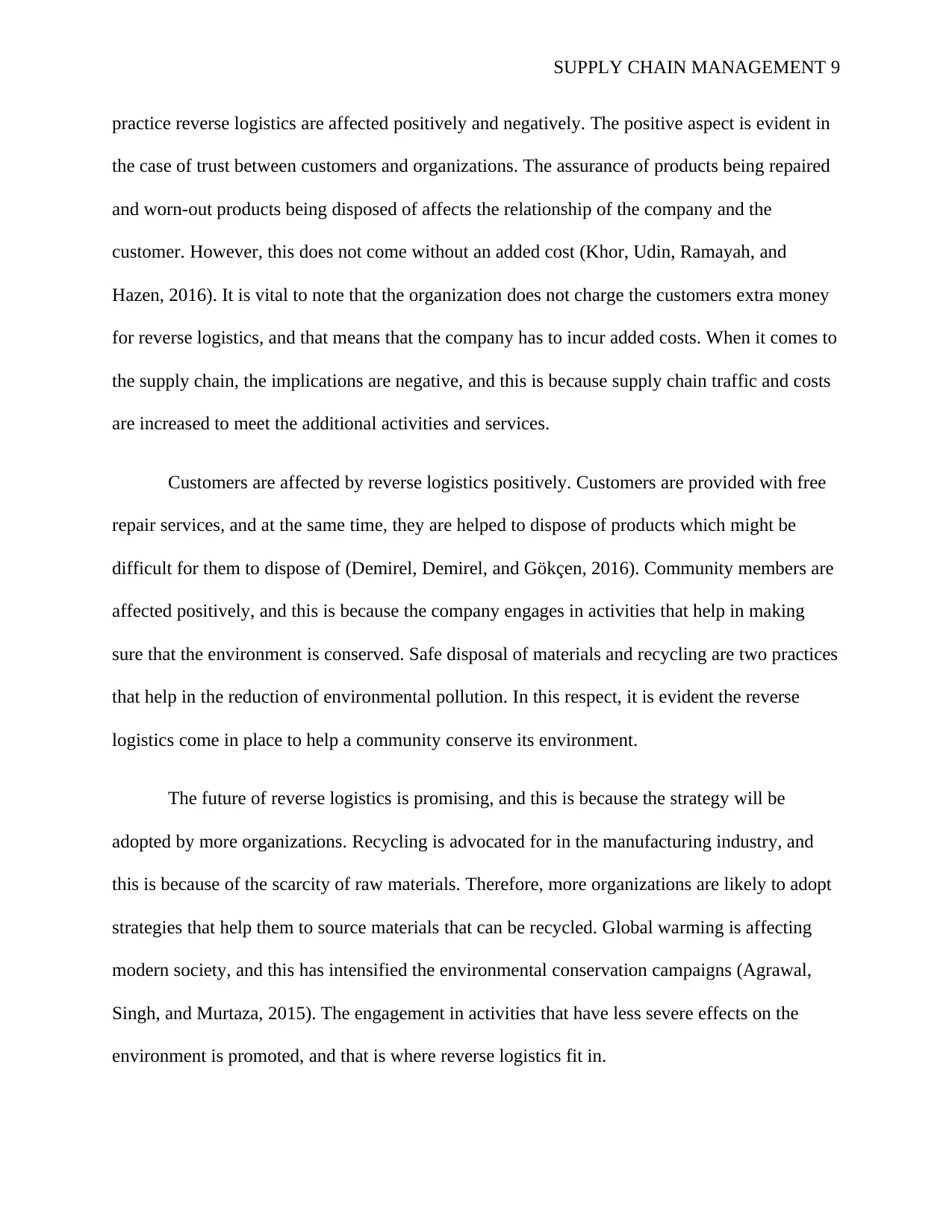
SUPPLY CHAIN MANAGEMENT 9
practice reverse logistics are affected positively and negatively. The positive aspect is evident in
the case of trust between customers and organizations. The assurance of products being repaired
and worn-out products being disposed of affects the relationship of the company and the
customer. However, this does not come without an added cost (Khor, Udin, Ramayah, and
Hazen, 2016). It is vital to note that the organization does not charge the customers extra money
for reverse logistics, and that means that the company has to incur added costs. When it comes to
the supply chain, the implications are negative, and this is because supply chain traffic and costs
are increased to meet the additional activities and services.
Customers are affected by reverse logistics positively. Customers are provided with free
repair services, and at the same time, they are helped to dispose of products which might be
difficult for them to dispose of (Demirel, Demirel, and Gökçen, 2016). Community members are
affected positively, and this is because the company engages in activities that help in making
sure that the environment is conserved. Safe disposal of materials and recycling are two practices
that help in the reduction of environmental pollution. In this respect, it is evident the reverse
logistics come in place to help a community conserve its environment.
The future of reverse logistics is promising, and this is because the strategy will be
adopted by more organizations. Recycling is advocated for in the manufacturing industry, and
this is because of the scarcity of raw materials. Therefore, more organizations are likely to adopt
strategies that help them to source materials that can be recycled. Global warming is affecting
modern society, and this has intensified the environmental conservation campaigns (Agrawal,
Singh, and Murtaza, 2015). The engagement in activities that have less severe effects on the
environment is promoted, and that is where reverse logistics fit in.
practice reverse logistics are affected positively and negatively. The positive aspect is evident in
the case of trust between customers and organizations. The assurance of products being repaired
and worn-out products being disposed of affects the relationship of the company and the
customer. However, this does not come without an added cost (Khor, Udin, Ramayah, and
Hazen, 2016). It is vital to note that the organization does not charge the customers extra money
for reverse logistics, and that means that the company has to incur added costs. When it comes to
the supply chain, the implications are negative, and this is because supply chain traffic and costs
are increased to meet the additional activities and services.
Customers are affected by reverse logistics positively. Customers are provided with free
repair services, and at the same time, they are helped to dispose of products which might be
difficult for them to dispose of (Demirel, Demirel, and Gökçen, 2016). Community members are
affected positively, and this is because the company engages in activities that help in making
sure that the environment is conserved. Safe disposal of materials and recycling are two practices
that help in the reduction of environmental pollution. In this respect, it is evident the reverse
logistics come in place to help a community conserve its environment.
The future of reverse logistics is promising, and this is because the strategy will be
adopted by more organizations. Recycling is advocated for in the manufacturing industry, and
this is because of the scarcity of raw materials. Therefore, more organizations are likely to adopt
strategies that help them to source materials that can be recycled. Global warming is affecting
modern society, and this has intensified the environmental conservation campaigns (Agrawal,
Singh, and Murtaza, 2015). The engagement in activities that have less severe effects on the
environment is promoted, and that is where reverse logistics fit in.
⊘ This is a preview!⊘
Do you want full access?
Subscribe today to unlock all pages.

Trusted by 1+ million students worldwide
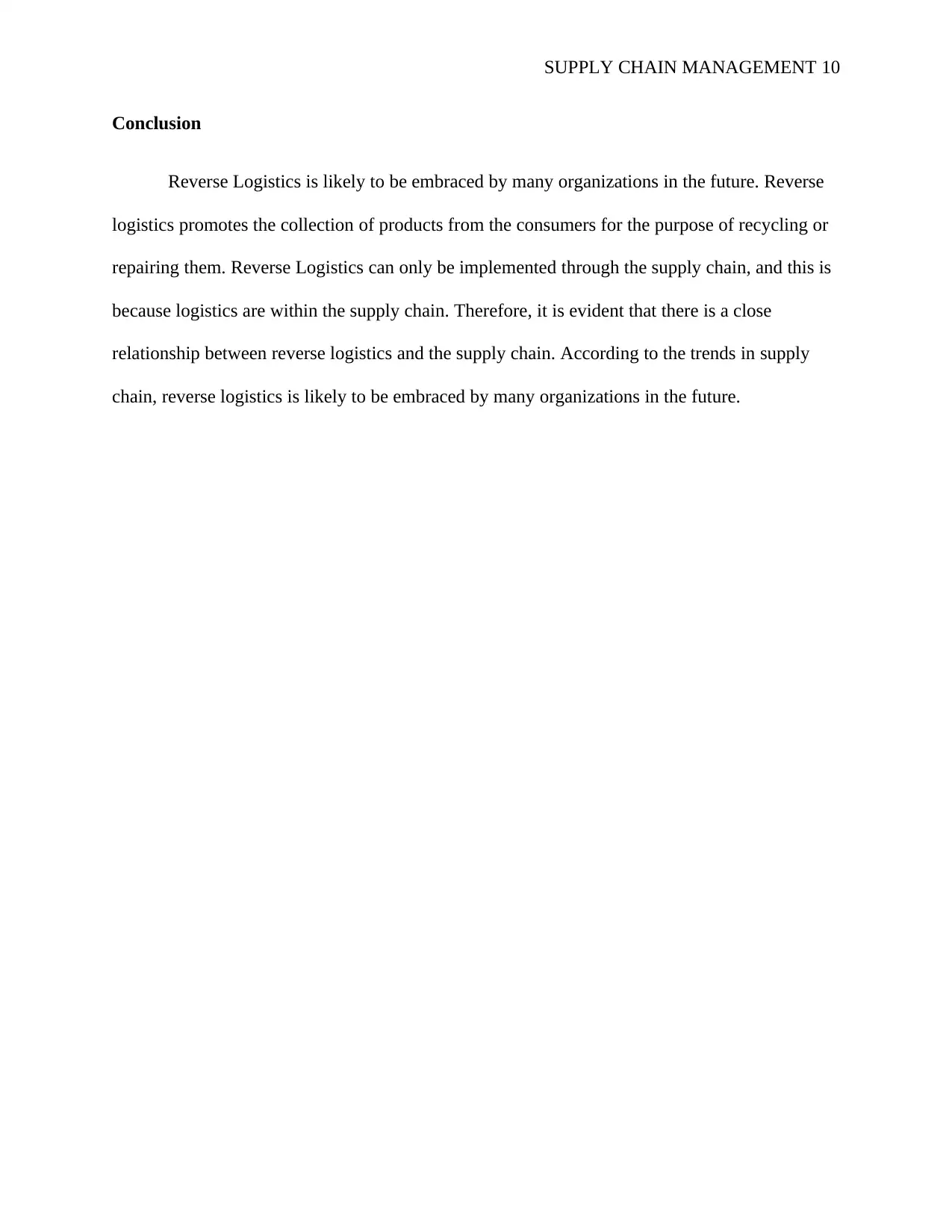
SUPPLY CHAIN MANAGEMENT 10
Conclusion
Reverse Logistics is likely to be embraced by many organizations in the future. Reverse
logistics promotes the collection of products from the consumers for the purpose of recycling or
repairing them. Reverse Logistics can only be implemented through the supply chain, and this is
because logistics are within the supply chain. Therefore, it is evident that there is a close
relationship between reverse logistics and the supply chain. According to the trends in supply
chain, reverse logistics is likely to be embraced by many organizations in the future.
Conclusion
Reverse Logistics is likely to be embraced by many organizations in the future. Reverse
logistics promotes the collection of products from the consumers for the purpose of recycling or
repairing them. Reverse Logistics can only be implemented through the supply chain, and this is
because logistics are within the supply chain. Therefore, it is evident that there is a close
relationship between reverse logistics and the supply chain. According to the trends in supply
chain, reverse logistics is likely to be embraced by many organizations in the future.
Paraphrase This Document
Need a fresh take? Get an instant paraphrase of this document with our AI Paraphraser
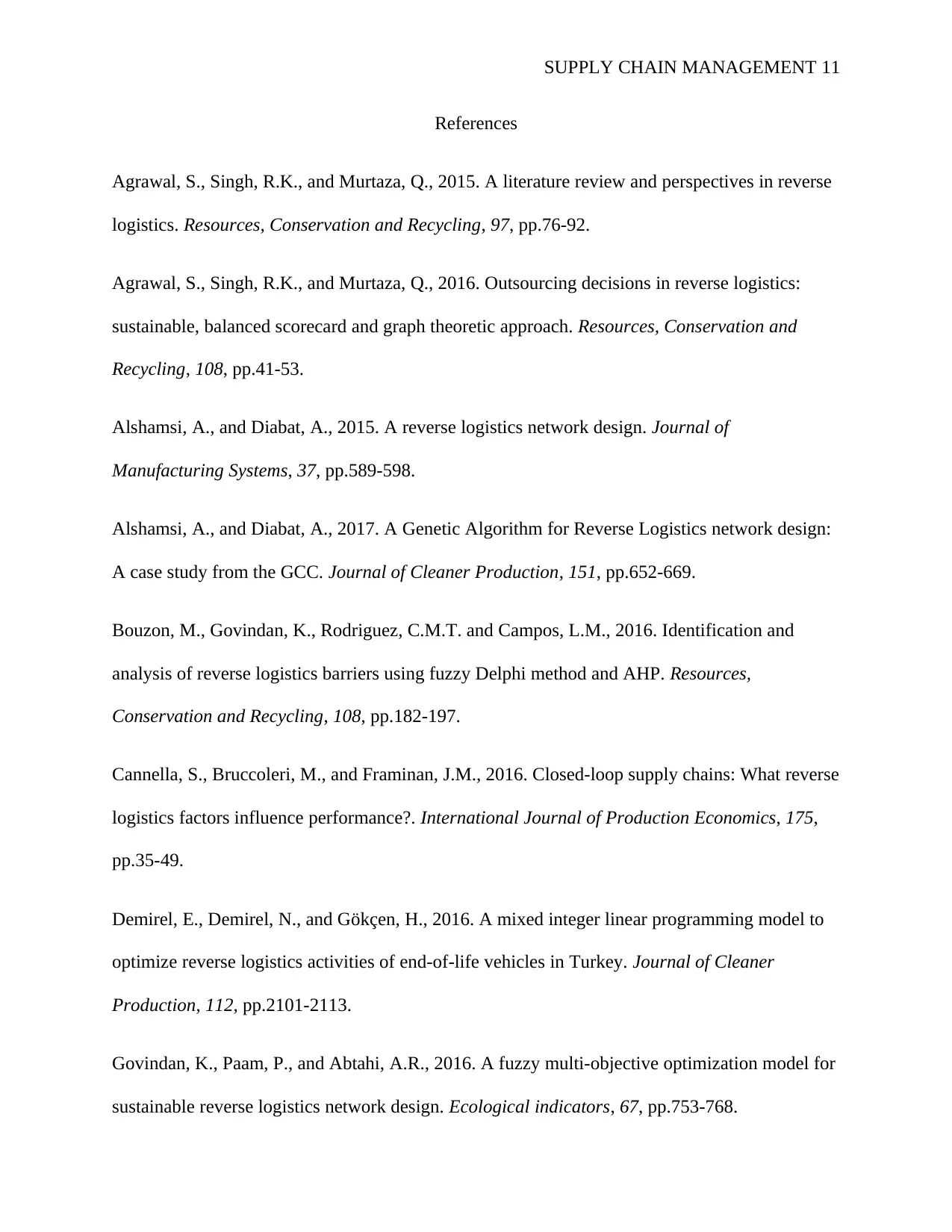
SUPPLY CHAIN MANAGEMENT 11
References
Agrawal, S., Singh, R.K., and Murtaza, Q., 2015. A literature review and perspectives in reverse
logistics. Resources, Conservation and Recycling, 97, pp.76-92.
Agrawal, S., Singh, R.K., and Murtaza, Q., 2016. Outsourcing decisions in reverse logistics:
sustainable, balanced scorecard and graph theoretic approach. Resources, Conservation and
Recycling, 108, pp.41-53.
Alshamsi, A., and Diabat, A., 2015. A reverse logistics network design. Journal of
Manufacturing Systems, 37, pp.589-598.
Alshamsi, A., and Diabat, A., 2017. A Genetic Algorithm for Reverse Logistics network design:
A case study from the GCC. Journal of Cleaner Production, 151, pp.652-669.
Bouzon, M., Govindan, K., Rodriguez, C.M.T. and Campos, L.M., 2016. Identification and
analysis of reverse logistics barriers using fuzzy Delphi method and AHP. Resources,
Conservation and Recycling, 108, pp.182-197.
Cannella, S., Bruccoleri, M., and Framinan, J.M., 2016. Closed-loop supply chains: What reverse
logistics factors influence performance?. International Journal of Production Economics, 175,
pp.35-49.
Demirel, E., Demirel, N., and Gökçen, H., 2016. A mixed integer linear programming model to
optimize reverse logistics activities of end-of-life vehicles in Turkey. Journal of Cleaner
Production, 112, pp.2101-2113.
Govindan, K., Paam, P., and Abtahi, A.R., 2016. A fuzzy multi-objective optimization model for
sustainable reverse logistics network design. Ecological indicators, 67, pp.753-768.
References
Agrawal, S., Singh, R.K., and Murtaza, Q., 2015. A literature review and perspectives in reverse
logistics. Resources, Conservation and Recycling, 97, pp.76-92.
Agrawal, S., Singh, R.K., and Murtaza, Q., 2016. Outsourcing decisions in reverse logistics:
sustainable, balanced scorecard and graph theoretic approach. Resources, Conservation and
Recycling, 108, pp.41-53.
Alshamsi, A., and Diabat, A., 2015. A reverse logistics network design. Journal of
Manufacturing Systems, 37, pp.589-598.
Alshamsi, A., and Diabat, A., 2017. A Genetic Algorithm for Reverse Logistics network design:
A case study from the GCC. Journal of Cleaner Production, 151, pp.652-669.
Bouzon, M., Govindan, K., Rodriguez, C.M.T. and Campos, L.M., 2016. Identification and
analysis of reverse logistics barriers using fuzzy Delphi method and AHP. Resources,
Conservation and Recycling, 108, pp.182-197.
Cannella, S., Bruccoleri, M., and Framinan, J.M., 2016. Closed-loop supply chains: What reverse
logistics factors influence performance?. International Journal of Production Economics, 175,
pp.35-49.
Demirel, E., Demirel, N., and Gökçen, H., 2016. A mixed integer linear programming model to
optimize reverse logistics activities of end-of-life vehicles in Turkey. Journal of Cleaner
Production, 112, pp.2101-2113.
Govindan, K., Paam, P., and Abtahi, A.R., 2016. A fuzzy multi-objective optimization model for
sustainable reverse logistics network design. Ecological indicators, 67, pp.753-768.
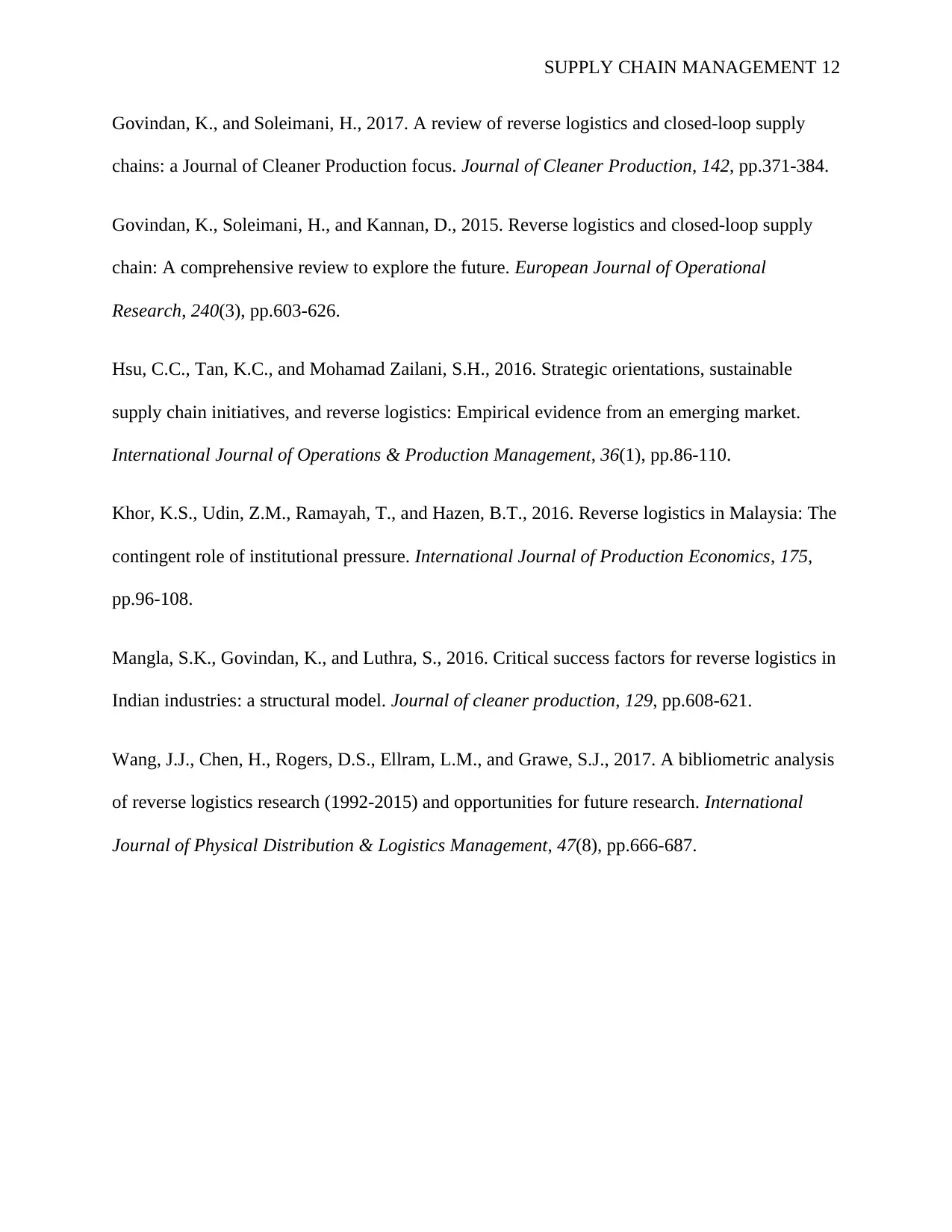
SUPPLY CHAIN MANAGEMENT 12
Govindan, K., and Soleimani, H., 2017. A review of reverse logistics and closed-loop supply
chains: a Journal of Cleaner Production focus. Journal of Cleaner Production, 142, pp.371-384.
Govindan, K., Soleimani, H., and Kannan, D., 2015. Reverse logistics and closed-loop supply
chain: A comprehensive review to explore the future. European Journal of Operational
Research, 240(3), pp.603-626.
Hsu, C.C., Tan, K.C., and Mohamad Zailani, S.H., 2016. Strategic orientations, sustainable
supply chain initiatives, and reverse logistics: Empirical evidence from an emerging market.
International Journal of Operations & Production Management, 36(1), pp.86-110.
Khor, K.S., Udin, Z.M., Ramayah, T., and Hazen, B.T., 2016. Reverse logistics in Malaysia: The
contingent role of institutional pressure. International Journal of Production Economics, 175,
pp.96-108.
Mangla, S.K., Govindan, K., and Luthra, S., 2016. Critical success factors for reverse logistics in
Indian industries: a structural model. Journal of cleaner production, 129, pp.608-621.
Wang, J.J., Chen, H., Rogers, D.S., Ellram, L.M., and Grawe, S.J., 2017. A bibliometric analysis
of reverse logistics research (1992-2015) and opportunities for future research. International
Journal of Physical Distribution & Logistics Management, 47(8), pp.666-687.
Govindan, K., and Soleimani, H., 2017. A review of reverse logistics and closed-loop supply
chains: a Journal of Cleaner Production focus. Journal of Cleaner Production, 142, pp.371-384.
Govindan, K., Soleimani, H., and Kannan, D., 2015. Reverse logistics and closed-loop supply
chain: A comprehensive review to explore the future. European Journal of Operational
Research, 240(3), pp.603-626.
Hsu, C.C., Tan, K.C., and Mohamad Zailani, S.H., 2016. Strategic orientations, sustainable
supply chain initiatives, and reverse logistics: Empirical evidence from an emerging market.
International Journal of Operations & Production Management, 36(1), pp.86-110.
Khor, K.S., Udin, Z.M., Ramayah, T., and Hazen, B.T., 2016. Reverse logistics in Malaysia: The
contingent role of institutional pressure. International Journal of Production Economics, 175,
pp.96-108.
Mangla, S.K., Govindan, K., and Luthra, S., 2016. Critical success factors for reverse logistics in
Indian industries: a structural model. Journal of cleaner production, 129, pp.608-621.
Wang, J.J., Chen, H., Rogers, D.S., Ellram, L.M., and Grawe, S.J., 2017. A bibliometric analysis
of reverse logistics research (1992-2015) and opportunities for future research. International
Journal of Physical Distribution & Logistics Management, 47(8), pp.666-687.
⊘ This is a preview!⊘
Do you want full access?
Subscribe today to unlock all pages.

Trusted by 1+ million students worldwide
1 out of 12
Related Documents
Your All-in-One AI-Powered Toolkit for Academic Success.
+13062052269
info@desklib.com
Available 24*7 on WhatsApp / Email
![[object Object]](/_next/static/media/star-bottom.7253800d.svg)
Unlock your academic potential
Copyright © 2020–2025 A2Z Services. All Rights Reserved. Developed and managed by ZUCOL.





